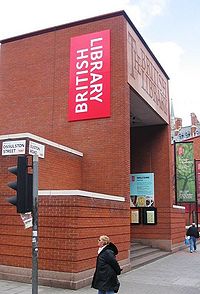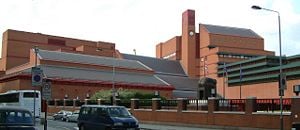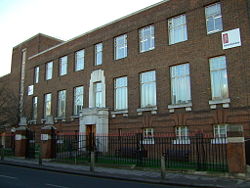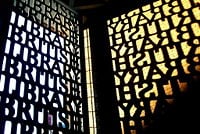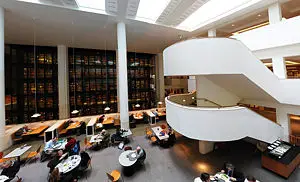British Library
The British Library (BL) is the national library of the United Kingdom. It is based in London and Boston Spa and is one of the world's most significant research libraries, holding over 150 million items. The Library's collections include around 25 million books, along with substantial additional collection of manuscripts and historical items dating back as far as 300 B.C.E. As of March 2004 the Library held 11.2 million monographs and received more than 41,500 regular serials. As a legal deposit library, the BL receives copies of nearly all books produced in the United Kingdom, including all foreign books distributed in the UK. It also purchases many items which are only printed abroad. The British Library adds some 3 million items every year.
History
As an institution the British Library is young compared with equivalent institutions in other countries, having been created in 1973 by the British Library Act 1972. Prior to this, the national library was part of the British Museum, which provided the bulk of the holdings of the new library, alongside various smaller organisations which were folded in (such as the British National Bibliography). In 1983, the Library absorbed the National Sound Archive. The core of the Library's historical collections are based on a series of donations and acquisitions from the eighteenth century, known as the 'foundation collections'. These include the books and manuscripts of Sir Robert Cotton, Sir Hans Sloane, Robert Harley and King George III.
For many years its collections were dispersed in various buildings around central London, in places such as Bloomsbury (right next to the British Museum), Chancery Lane, and Holborn, with the lending library at Boston Spa, Yorkshire and the newspaper library at Colindale, north-west London. However, since 1997 the main collection has been housed in a single new building on Euston Road next to St. Pancras railway station. The new library was designed specially for the purpose by the architect Colin St. John Wilson. Facing Euston Road is a large piazza that includes pieces of Public Art by Eduardo Paolozzi (a bronze statue based on William Blake's study of Isaac Newton) and Anthony Gormley. It is the largest public building constructed in the United Kingdom in the 20th century. However, post-1800 newspapers are still held at Colindale, North London, and the Document Supply collection is held at the Boston Spa site in Yorkshire. The Library also has a book store in Woolwich.
At the heart of the building is a four-storey glass tower containing The King's Library, with 65,000 printed volumes along with other pamphlets, manuscripts and maps collected by King George III between 1763 and 1820. The tower's design by Yale University's Beinecke Library.
Collections
The Library's collection is currently around 25 million volumes.[1] In the British Library's Digital library project collections can be toured online and the virtual pages of Leonardo da Vinci's notebooks and other great works can be turned electronically. The British Library's secure electronic delivery service, started in 2003 at a cost of 6 million pounds, brings access to more than one hundred million items (including 280,000 journal titles, 50 million patents, 5 million reports, 476,000 U.S. dissertations and 433,000 conference proceedings) for researchers and library patrons worldwide which were previously unavailable outside the Library due to copyright restrictions. The use of the Library's web catalogue also continues to increase. In 2003 more than 9.7 million searches were conducted.
Unlike the Library of Congress, the British Library does not specifically serve the legislature. Parliament has its own libraries, the House of Commons Library and the House of Lords Library. The Guinness Book of World Records currently lists the American Library of Congress as the "World's Largest Library".[2] However, this is based on the shelf space the collection occupies; the Library of Congress states that its collection fills about 530 miles (850 km),[3] while the British Library reports about 388 miles (625 km) of shelves.[4] On the other hand, the Library of Congress holds about 130 million items with 29 million books,[5] as against approximately 150 million items with 25 million books for the British Library.
The British Library also holds the Oriental and India Office Collections (OIOC), Now called APAC (Asia, Pacific & Africa Collections) which contain the collections of the India Office Library and Records, and materials in the languages of Asia and of north and north-east Africa.
Legal deposit
An Act of Parliament in 1911 established the principle of the Legal Deposit, ensuring that the British Library, along with five other libraries in Great Britain and Ireland, is entitled to receive a free copy of every item published in the United Kingdom and the Republic of Ireland. The other five libraries are: the Bodleian Library at Oxford; the University Library at Cambridge; Trinity College Library in Dublin; and the National Libraries of Scotland and Wales. The British Library is the only one that must receive a copy of every item published in Britain; the others are entitled to these items but must specifically request them from the publisher.
In 2003 the Ipswich MP Chris Mole introduced a Private Member's Bill which eventually passed, becoming the Legal Deposit Libraries Act 2003. This Act extends the Legal Deposit requirements to electronic documents such as CD-ROMs and selected websites. The BL explains its policies on legal deposit here.
Newspapers
The British Library Newspapers section is based in Colindale in North London. The Library has a more or less complete collection of British and Irish newspapers since 1840, owing in part to legal deposit legislation of 1869 mandating that the Library receive a copy of each edition of a newspaper. London editions of national daily and Sunday newspapers are complete back to 1801. In total the collection consists of 660,000 bound volumes and 370,000 reels of microfilm containing tens of millions of newspapers with 52,000 titles on 45km of shelves.
A collection of particular interest is the Thomason Tracts, containing 7,200 seventeenth century newspapers, and the Burney Collection featuring newspapers from the late eighteenth and early nineteenth centuries. The Thomason Tracts and Burney collections are held at St Pancras, and are available in facsimile.
The section also has extensive records of non-British newspapers in languages that use the Latin and Cyrillic alphabets. The collection is less substantial for languages of the Middle East and the rest of Asia, though some holdings of these are held at the main library in St. Pancras.
Philatelic collections
The British Library Philatelic Collections are the National Philatelic Collections of the United Kingdom. The Collections were established in 1891 with the donation of the Tapling Collection, they steadily developed and now comprise over twenty five major collections and a number of smaller ones, encompassing a wide-range of disciplines. The collections include postage and revenue stamps, postal stationery, essays, proofs, covers and entries, 'cinderella stamp' material, specimen issues, airmails, some postal history materials, official and private posts, etc., for almost all countries and periods.
An extensive display of material from the collections is on exhibit and is probably the best permanent display of diverse classic stamps and philatelic material in the world. Approximately 80,000 items on 6,000 sheets may be viewed in 1,000 display frames; 2,400 sheets are from the Tapling Collection. All other material, which covers the whole world, is available to students and researchers by appointment.
As well as these extensive collections, the subject literature is very actively acquired, and makes the British Library one of the world's prime philatelic research centres.
Highlights of the collections
- The Stein collection from Central Asia.
- The Diamond Sutra, claimed to be the world's oldest dated printed book
- The Lindisfarne Gospels
- Two Gutenberg Bibles
- Two 1215 copies of Magna Carta
- Papyrus Egerton 2, the Egerton Gospel
- The only surviving manuscript copy of the poem Beowulf
- 347 leaves of the Codex Sinaiticus
- The Codex Arundel one of Leonardo da Vinci's notebooks.
- Working manuscripts by J.S. Bach, W.A. Mozart, Gustav Mahler and Benjamin Britten.
Facilities
A number of important works are on display to the general public in a gallery called "Sir John Ritblat Gallery: Treasures of the British Library" which is open to the public seven days a week at no charge. The Library also stages temporary exhibitions on a wide range of subjects which can be illuminated by the items in its collection - which is almost anything, not just literature. Recent exhibitions include Elizabeth Barrett Browning and Benjamin Franklin (2006).
Other items can be accessed in the reading rooms. In the past the Library emphasized its role as a "library of last resort" for people who needed access to deep and specialized collections which they could not find anywhere else. Nowadays it adopts a more welcoming approach and emphasizes on its website that anyone who wishes to carry out research can register for a reader's pass, providing they furnish the necessary identification for security purposes. The Library has come under criticism for admitting undergraduate students (who have access to their own university libraries) to the reading rooms, but the Library says that they have always admitted undergraduates as long as they have a legitimate personal, work-related or academic research purpose.[6]
Catalogue entries can be found on the British Library Integrated Catalogue, which is based on Aleph (a commercial Integrated Library System). Western Manuscripts are indexed and described on MOLCAT and the Digital Catalogue of Illuminated Manuscripts. The Library's website also offers other specialised catalogues and research services.
According to the website, more than half a million people use the Library's reading rooms every year. The large reading rooms cover hundreds of seats which are often filled with researchers every day, especially during the Easter and Summer vacations.
Business & IP Centre
In May 2005, the British Library was awarded £1 million by the London Development Agency to transform two of its reading rooms into the Business & IP (Intellectual Property) Centre. The Centre was opened as a permanent resource in March 2006. It holds arguably the most comprehensive collection of business and intellectual property in the United Kingdom and is the official library of the UK Patent Office.
The Business & IP Centre is separated into two distinct areas:
Business information
The collection is divided up into four main information areas: market research; company information; trade directories; and journals. It is available for free in hard copy and online via approximately 30 subscription databases. You must have a reader pass to access the collection and the databases.
Patent and intellectual property information
There are over 50 million patent specifications from 40 countries in a collection dating back to 1855. The collection also includes official gazettes on patents, trade marks and Registered Design; Law reports and other material on litigation; and information on copyright. This is available in hard copy and via online databases. You must have a reader pass to access the collection and the databases.
Impartial information experts are trained to guide SMEs and Entrepreneurs to use the full range of resources. The Business & IP Centre also offers additional services including:
• The provision of a networking area for SMEs to meet and network with other SMEs, find out about the Library's full range of services and get inspiration from success stories about products and services conceived by other centre users.
• Workshops and clinics run by the British Library and its business partners on subjects including: using intellectual property resources to check if ideas are novel, how to protect your ideas & designs, capitalising on market research resources, financing, marketing and selling skills, and pinpointing customers. Some of these workshops have a specific focus on supporting the needs of women, black and Asian minority ethnic groups, and entrepreneurs with disabilities. These are free or charged at a subsidised rate.
• Events featuring successful entrepreneurs. Previous events have included ‘Winners – The Rise and Rise of Black British Entrepreneurs’, ‘The Asian Advantage’, ‘Mothers of Invention’, and talks by Anita Roddick. These are available as webcasts.
Notes
- ↑ Encyclopædia Britannica Article: British Library
- ↑ Guiness World Records: Amazing Feats: Big Stuff: Library: Largest library
- ↑ Welcome Message from the Librarian of Congress
- ↑ The British Library: About us: Did you know?
- ↑ Welcome Message from the Librarian of Congress
- ↑ A.N. Wilson, Evening Standard; Tristram Hunt, Guardian.
ReferencesISBN links support NWE through referral fees
- Philatelic collections. Retrieved April 4, 2005.
- Barker, Nicolas. 2005. Treasures of the British Library. British Library. ISBN 0712348905 ISBN 978-0712348904
- Day, Alan Edwin. 1998. Inside the British Library. Library Association Publishing (UK). ISBN 1856042804 ISBN 978-1856042802
- Sussex, John (editor) (1990). Stamp World London 90, souvenir handbook. Stamp World Exhibitions. ISBN 0-9515891-0-5.
- The Curators. 2007. British Library Diary 2007: Moments from History. Frances Lincoln. ISBN 0711226202 ISBN 978-0711226203
External links
- The British Library homepage
- The British Library Catalogue
- The King's Library contained within The British Library
- The 'Bibliotheca Universalis' homepage
- The World's Earliest Dated Printed Book
- Turning the Pages, digitizations of a few important books, with explanations (Macromedia Shockwave format)
- The British Library Act, 1972
- The Business & IP Centre homepage
Credits
New World Encyclopedia writers and editors rewrote and completed the Wikipedia article in accordance with New World Encyclopedia standards. This article abides by terms of the Creative Commons CC-by-sa 3.0 License (CC-by-sa), which may be used and disseminated with proper attribution. Credit is due under the terms of this license that can reference both the New World Encyclopedia contributors and the selfless volunteer contributors of the Wikimedia Foundation. To cite this article click here for a list of acceptable citing formats.The history of earlier contributions by wikipedians is accessible to researchers here:
The history of this article since it was imported to New World Encyclopedia:
Note: Some restrictions may apply to use of individual images which are separately licensed.
